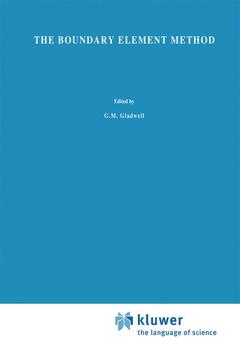Description
The Boundary Element Method, 1994
Coll. Solid Mechanics and Its Applications, Vol. 27
Author: Hall W.S.
Language: French
Subjects for The Boundary Element Method:
Keywords
Approximation; Mathematica; calculus; elastostatics; mathematics; statics
Publication date: 10-2012
230 p. · 15.5x23.5 cm · Paperback
230 p. · 15.5x23.5 cm · Paperback
Description
/li>Contents
/li>
The Boundary Element Method is a simple, efficient and cost effective computational technique which provides numerical solutions - for objects of any shap- for a wide range of scientific and engineering problems. In dealing with the development of the mathematics of the Boundary Element Method the aim has been at every stage, only to present new material when sufficient experience and practice of simpler material has been gained. Since the usual background of many readers will be of differential equations, the connection of differential equations with integral equations is explained in Chapter 1, together with analytical and numerical methods of solution. This information on integral equations provides a base for the work of subsequent chapters. The mathematical formulation of boundary integral equations for potential problems - derived from the more familiar Laplace partial differential equation which governs many important physical problems - is set out in Chapter 2. It should be noted here that this initial formulation of the boundary integral equations reduces the dimensionality of the problem. In the key Chapter 3, the essentials of the Boundary Element Method are presented. This first presentation of the Boundary Element Method is in its simplest and most approachable form - two dimensional, with the shape of the boundary approximated by straight lines and the functions approximated by constants over each of the straight lines.
1 Ordinary Integral Equations.- 1.1 Introduction.- 1.2 Ordinary Integral Equations and their Applications.- 1.3 Equivalence between Ordinary Integral and Ordinary Differential Equations.- 1.4 Analytical Methods of Solution.- 1.5 Numerical Methods of Solution.- 1.6 Concluding Remarks.- Exercises.- 2 Two Dimensional Potential Problems.- 2.1 Introduction.- 2.2 Applications of Potential Formulations.- 2.3 Boundary Integral Equation Derivation for Interior Problems.- 2.4 Boundary Integral Equation Derivation for Exterior Problems.- 2.5 Treatment of Boundary Conditions.- 2.6 Concluding Remarks.- Exercises.- 3 Boundary Element Method.- 3.1 Introduction.- 3.2 Numerical Foundation.- 3.3 Linear Approximation.- 3.4 Integration on a Curve.- 3.5 Constant Function Solution for Exterior Heat Conduction.- 3.6 Evaluation of Logarithmic Integral Coefficients.- 3.7 Concluding Remarks.- Exercises.- 4 Linear Isoparametric Solution.- 4.1 Introduction.- 4.2 Linear Function Approximation for Exterior Heat Conduction.- 4.3 Assembly of Left Hand Side Coefficients.- 4.4 Singular and Nonsingular Elements.- 4.5 Evaluation of Right Hand Side Terms.- 4.6 Exterior Neumann Problem for Velocity Potential.- 4.7 Singularity Elimination for the Derivative Kernel.- 4.8 Interior Mixed Boundary Value Problem.- 4.9 Concluding Remarks.- Exercises.- 5 Quadratic Isoparametric Solution.- 5.1 Introduction.- 5.2 Interior Mixed Boundary Value Problems.- 5.3 Treatment of Singular Integrals.- 5.4 Subtraction and Series Expansion Method for Singular Integration.- 5.5 Concluding Remarks.- Exercises.- 6 Three Dimensional Potential Problems.- 6.1 Introduction.- 6.2 Boundary Integral Equation Formulation.- 6.3 Electrostatics Application.- 6.4 Shape functions and boundary elements.- 6.5 The Boundary Element Method.- 6.6 Surface Jacobian.- 6.7 Assembly of Coefficients.- 6.8 Generation of a System of Equations.- 6.9 Summary of the Three Dimensional Boundary Element Method.- 6.10 Concluding Remarks.- Exercises.- 7 Numerical Integration for Three Dimensional Problems.- 7.1 Introduction.- 7.2 Integration in the Local Coordinate Plane.- 7.3 Singular Integration.- 7.4 Concluding Remarks.- Exercises.- 8 Two-Dimensional Elastostatics.- 8.1 Introduction.- 8.2 Review of Linear Elasticity.- 8.3 Derivation of the Boundary Integral Equation.- 8.4 Boundary Element Solution.- 8.5 Concluding remarks.- Exercises.- Appendix A Integration and Differentiation Formulae.- Appendix B Matrix Partitioning for the Mixed Boundary Value Problem.- Appendix C Answers to Selected Exercises.
© 2024 LAVOISIER S.A.S.




